人教版新目标九年级英语Unit9单元集体备课教案
人教版新目标九年级英语教案Unit9第九单元教学设计
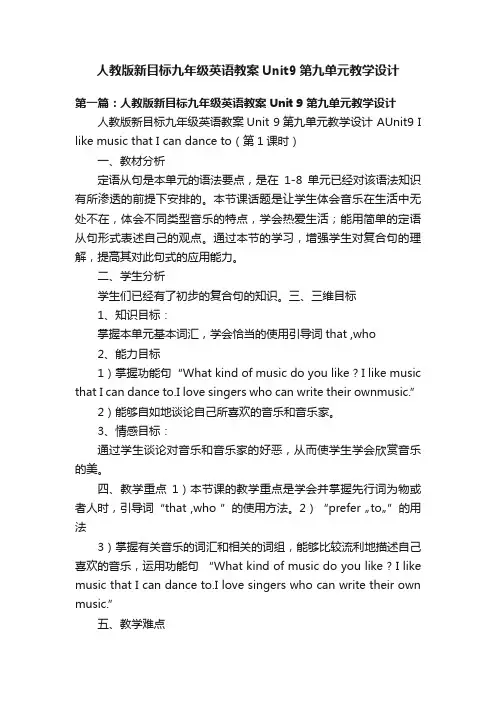
人教版新目标九年级英语教案Unit9第九单元教学设计第一篇:人教版新目标九年级英语教案Unit 9第九单元教学设计人教版新目标九年级英语教案Unit 9第九单元教学设计 AUnit9 I like music that I can dance to(第1课时)一、教材分析定语从句是本单元的语法要点,是在1-8单元已经对该语法知识有所渗透的前提下安排的。
本节课话题是让学生体会音乐在生活中无处不在,体会不同类型音乐的特点,学会热爱生活;能用简单的定语从句形式表述自己的观点。
通过本节的学习,增强学生对复合句的理解,提高其对此句式的应用能力。
二、学生分析学生们已经有了初步的复合句的知识。
三、三维目标1、知识目标:掌握本单元基本词汇,学会恰当的使用引导词that ,who2、能力目标1)掌握功能句“What kind of music do you like ? I like music that I can dance to.I love singers who can write their ownmusic.”2)能够自如地谈论自己所喜欢的音乐和音乐家。
3、情感目标:通过学生谈论对音乐和音乐家的好恶,从而使学生学会欣赏音乐的美。
四、教学重点1)本节课的教学重点是学会并掌握先行词为物或者人时,引导词“that ,who ”的使用方法。
2)“prefer …to…”的用法3)掌握有关音乐的词汇和相关的词组,能够比较流利地描述自己喜欢的音乐,运用功能句“What kind of music do you like ? I like music that I can dance to.I love singers who can write their own music.”五、教学难点定语从句运用六、教学策略采用任务型语言教学,实施情境教学法、小组合作探究法、情感激励法。
七、教学准备自制多媒体课件(PowerPoint);录音机(A tape recorder)八、教学环节1、课堂导入⑴ Warming up ⑵ Discuss: Do you like music? What kind ofmusic do you know? ⑶ There aremany kinds of music such as pop ,jazz, rock…….Let Sstalk about the kinds of music..(多媒体出示)⑷Let Ss read 1a.Explain the sentences: I prefermusic that has great lyrics=I like music that has great lyrics better.lyrics:the plural form is often used.Ask Ss topractice in pairs then make up a short passage using the four sentences on thescreen.2、课堂讲授Explain attributive clauses.定语从句:在复合句中修饰名词或者代词的从句叫做定语从句。
unit9教案(人教新目标初三)doc初中英语
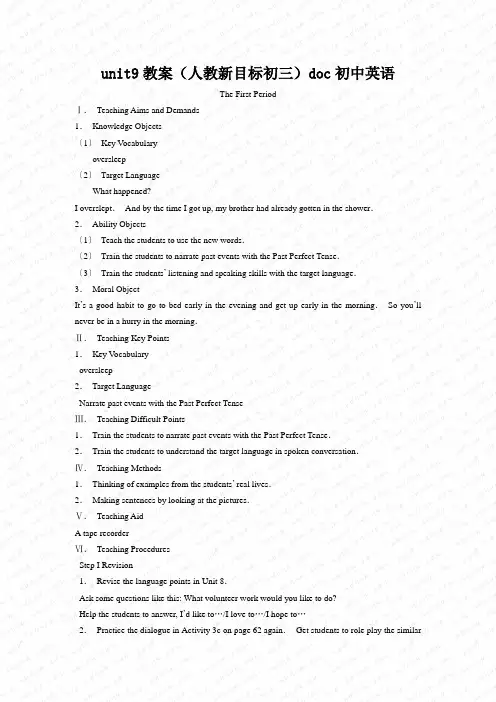
unit9教案(人教新目标初三)doc初中英语The First PeriodⅠ.Teaching Aims and Demands1.Knowledge Objects〔1〕Key Vocabularyoversleep〔2〕Target LanguageWhat happened?I overslept.And by the time I got up, my brother had already gotten in the shower.2.Ability Objects〔1〕Teach the students to use the new words.〔2〕Train the students to narrate past events with the Past Perfect Tense.〔3〕Train the students’ listening and speaking skills with the target language.3.Moral ObjectIt’s a good habit to go to bed early in the evening and get up early in the morning.So you’ll never be in a hurry in the morning.Ⅱ.Teaching Key Points1.Key Vocabularyoversleep2.Target LanguageNarrate past events with the Past Perfect TenseⅢ.Teaching Difficult Points1.Train the students to narrate past events with the Past Perfect Tense.2.Train the students to understand the target language in spoken conversation.Ⅳ.Teaching Methods1.Thinking of examples from the students’ real lives.2.Making sentences by looking at the pictures.Ⅴ.Teaching AidA tape recorderⅥ.Teaching ProceduresStep I Revision1.Revise the language points in Unit 8.Ask some questions like this: What volunteer work would you like to do?Help the students to answer, I’d like to…/I love to…/I hope to…2.Practice the dialogue in Activity 3c on page 62 again.Get students to role play the similardialogues with the following.S A: I’d like to join the school volunteer project, but I’m not sure what I should do.S B: What do you like doing?S A: I love playing football.S B: Well, you could help coach a football team for little kids.Let the children practice in pairs.3.Check the students’homework by asking some students to read their sentences with the phrasal verbs.Then ask the students to hand in their homework.4.Dictate the following words:clean up, cheer up, give out, put off, set up, run out of, take after, fix up, giveaway, call up, hand out, work out, hunger, establish, commitment, veterinarian, strategyStep Ⅱ1aThis activity introduces new vocabulary which can be used to narrate past events.First write by the time on the blackboard.and tell the class the meaning of it."by the time" means not later than, before, as soon as, or when the indicated comes.When we use the words."By the time…, "we are talking about two different things that happened in the past.Say this sentence to the class: By the time the teacher came in, the students had begun reading English.Tell them to note the struture "had begun" in this sentence.Begun is the past participle of begin.When we talk about two events both happened in the past, the one which happened earlier should use and plus a past participle.The words following By the time…, talk about the thing that happened later.And tell the students when they use had plus a past participle, they are using the Past Perfect Tense.Also explain what is the past participle form of a verb for the students.Tell them it is as the same as the past form for a regular verb.And they have to remember the irregular verbs’ participles one by one.Play a game to help the students understand the sentences with the words By the time…Do it like this:Pretend that the teacher will leave the classroom and the students will do some things.When the teacher returns.the class will make statements starting with By the time…Write By the time I came back…on the blackboard.Say to the class, By the time I came in.what had happened?Help one student to answer like this, By the time the teacher came in, Don had written his name on the blackboard.Then get more students to answer differently, such as,By the lime the teacher came in, we had discussed an English problem.By the time the teacher came in, I had drawn a picture.Write these sentences on the blackboard, and teach the students to read several times.Read the instructions to the students and read these questions to the class as well.What do you usually do in, the morning before school? Do you like morning?Why or why not?Choose one good student to answer them by saying something he or she usually does in the morning.He or she may answer like this,I usually get up early, wash my face and have breakfast.I like mornings because the air is fresh, or I usually get up as late as possible.Then I have to wash my face and have breakfast in a hurry.I often rush to school without breakfast.Sometimes I forget something at home.I don’t like mornings because I am always too busy.Then have the whole class practice in pairs.Ask each other the questions.After they finish talking, ask one or two pairs to say their conversations to the class.Correct the mistakes they may make with the other students.Call the students’ attention to the pictures in Activity la.Ask students to tell what they see.Say, Any sentences which make sense are accepted to describe the pictures.The girl in the pictures is Tina.Present the new words by providing sentences showing the meanings of them like this:T: What can you see in Picture 1?S1: She slept a long time.T: That’s correct.She slept too late.She overslept.Class repeat.She overslept.S s: She overslept.T: What do you see in Picture 2?S2: Her brother or sister is in the bathroom.T: That’s correct.She wants to go into the bathroom.She can’t because someone is taking a shower.Class repeat.Someone is taking a shower.S s: Someone is taking a shower.Write these words on the blackboard:overslept, taking a shower, had left, left her backpack at home.Then tell students to talk about the pictures in groups of four.Move around the classroom, listening to students and offering help.Make sure that they talk in English.After they all finish talking, ask different groups to tell the class about the pictures.They may say like this:Tina overslept in the morning.She wanted to go to the bathroom, but her brother had already gotten in the shower.When she got to the bus stop, the bus had already left.She had to run to school.After she got to school, she realized she had left her backpack at home.The sentences can vary, but should be correct.Step Ⅲ1bThis activity gives students practice in understanding the target language in spoken conversation.Ask the students to read the instructions together.Have them look at the two columns, A and B ,in the chart.Point out the sample answer.Read the two parts of the sentence.Then go over the other unconnected parts of sentences, too.You will connect the two parts of the sentences, connect a sentence beginning in the first column with the end of that sentence in the second column.Please guess the other two sentences before I play the tape.I guess most of the children can get the correct sentences by guessing.So just let them guess.Don’t tell them whether their answers are right or wrong.OK, just keep your answers by guessing.Let’s decide if they are right by listening to the tape now.Play the recording for the first time.Students only listen.Then play it a second time.Let students match two parts of each sentence.Check the answers by asking some students to tell their answers.Make sure that all of them have got the correct answers by listening.Say congratulations to the students who get the answers correctly by guessing.Answers1.b 2.a 3.cTapescriptBoy: Hi, Tina.You look stressed out.Girl: I am.I had a bad morning.Boy: Really? What happened?Girl: Well, first of all I overslept.By the time I got up, my brother had already gotten in the shower.Boy: Oh, what a pain!Girl: So, after he got out of shower, I took a quick shower and got dressed.But by the time I went outside, the bus had already left.Boy: Oh, no!Girl: Oh, yes! So I ran all the way to school.But when I got to school, I realized I had left my backpack at home.Boy: No wonder you look stressed out.Step Ⅳ1cThis practice provides guided oral practice using the target language.First play the recording in Activity 1bagain and let the students read after it.Do it at least twice.Then read the instructions together with the whole class.You will make conversations in pairs.Each of you will have to take turns being Tina.Look at the pictures in Activity la to help you.Tell your partner what happened to you this morning.Ask a pair to read the example to the class before they begirtS A: What happened?S B: I overslept.And by the time I got up, my brother had already gotten in the shower.Write the conversation on the blackboard.Have the students work in pairs.Move around the room offering language support as needed.After they all finish talking, ask some pairs to say their conversations to the class.Step ⅤSummarySay, In this class, we’ve learned how to narrate past events, using the Past Perfect Tense.We’ve also done some listening practice in understanding the target language in spoken conversation.Also, we’ve done much oral practice using the target language.Step ⅥHomework1.Write out the story of Tina, Note to use the target language.2.Revise when to use the Past Perfect Tense and the verb structure of it.Step ⅦBlackboard DesignUnit 9 By the time I got outside, thebus had already left.Section AThe First Period1.By the time…By the time the teacher came in, the students had begun reading.By the time the teacher came in, Don had written his name on the blackboard.By the time the teacher came m, we had discussed an English problem.2.Some words to describe the pictures overslept, taking a shower, had left, left herbackpack at home.3.Target Language:A: What happened?B:I overslept.And by the time I got up, my brother had already gottenin the shower.。
人教新目标九年级英语全册教案:Unit9 教案
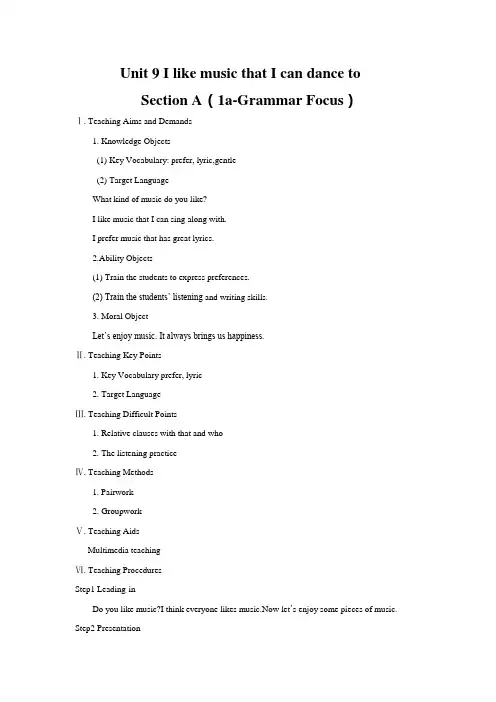
Unit 9 I like music that I can dance toSection A(1a-Grammar Focus)Ⅰ. Teaching Aims and Demands1. Knowledge Objects(1) Key Vocabulary: prefer, lyric,gentle(2) Target LanguageWhat kind of music do you like?I like music that I can sing along with.I prefer music that has great lyrics.2.Ability Objects(1) Train the students to express preferences.(2) Train the students’ listening and writing skills.3. Moral ObjectLet’s enjoy music. It always brings us happiness.Ⅱ. Teaching Key Points1. Key Vocabulary prefer, lyric2. Target LanguageⅢ. Teaching Difficult Points1. Relative clauses with that and who2. The listening practiceⅣ. Teaching Methods1. Pairwork2. GroupworkⅤ. Teaching AidsMultimedia teachingⅥ. Teaching ProceduresStep1 Leading-inDo you like music?I think everyone likes music.Now let’s enjoy some pieces of music.Step2 PresentationPlay a piece of music.Then ask the students:Do you like the music?What do you think ofit?Help the students to answer it.Then say , I like music that I can dance to.In this way,play some other kinds of music for the students and let them try to say “Ilike/prefer music that has great lyrics,…that I can sing along with,…that isn’t too loud, …”. Tell the students prefer means like …better.(设计意图:先描述对各种音乐的感觉,引导学生学会用定语从句表达自己喜欢的各种音乐。
人教版新目标九年级英语Unit9单元集体备课教案
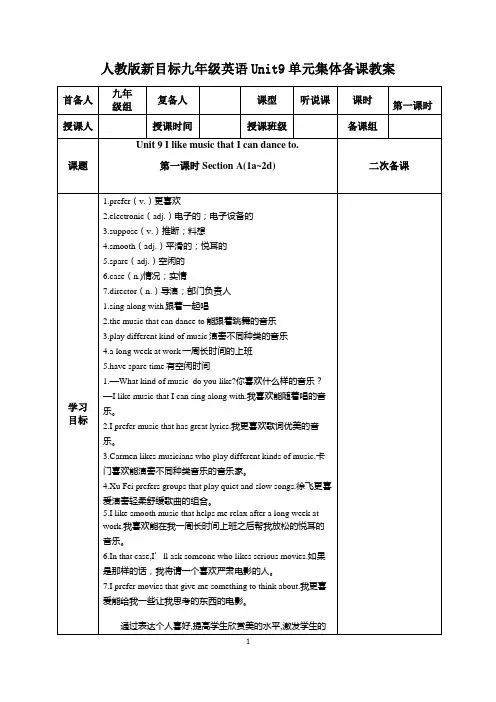
Step 2完成教材1a-1c的任务
【操作案例】
1.要求学生翻开课本P65,迅速阅读1a部分的内容。并按要求完成课本上相应的任务。(1分钟)
2.核对答案,先要求全班一起给出答案并检查讨论。然后要求2-3名同学就“I like music that ”给出自己的答案,并把收集的答案列举在黑板上。(3分钟)
3.suppose(v.)推断;料想
4.smooth(adj.)平滑的;悦耳的
5.spare(adj.)空闲的
6.case(n.)情况;实情
7.director(n.)导演;部门负责人
1.sing along with跟着一起唱
2.the music that can dance to能跟着跳舞的音乐
人教版新目标九年级英语Unit9单元集体备课教案
首备人
九年
级组
复备人
课型
听说课
课时
第一课时
授课人
授课时间
授课班级
备课组
课题
Unit 9I like music that I can dance to.
第一课时Section A(1a~2d)
二次备课
学习
目标
1.prefer(v.)更喜欢
2.electronic(adj.)电子的;电子设备的
Questions:
1.What movies do you like to watch?
_______________________________________
2.What’s your favorite movie?
人教版新目标九年级英语教案Unit9第九单元教学设计
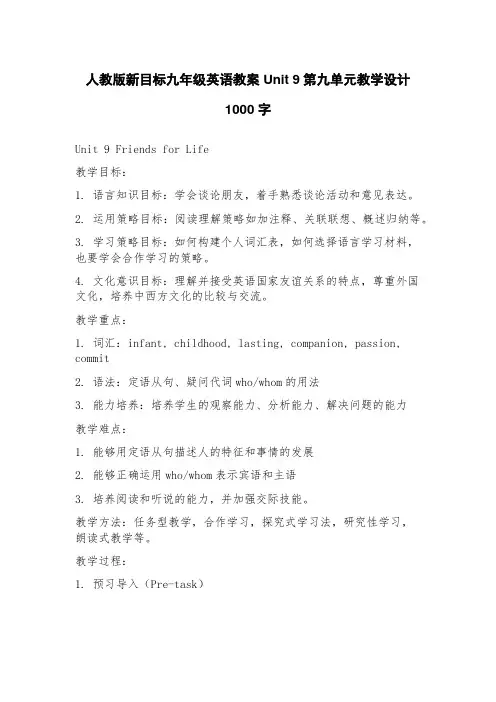
人教版新目标九年级英语教案Unit 9第九单元教学设计1000字Unit 9 Friends for Life教学目标:1. 语言知识目标:学会谈论朋友,着手熟悉谈论活动和意见表达。
2. 运用策略目标:阅读理解策略如加注释、关联联想、概述归纳等。
3. 学习策略目标:如何构建个人词汇表,如何选择语言学习材料,也要学会合作学习的策略。
4. 文化意识目标:理解并接受英语国家友谊关系的特点,尊重外国文化,培养中西方文化的比较与交流。
教学重点:1. 词汇:infant, childhood, lasting, companion, passion, commit2. 语法:定语从句、疑问代词who/whom的用法3. 能力培养:培养学生的观察能力、分析能力、解决问题的能力教学难点:1. 能够用定语从句描述人的特征和事情的发展2. 能够正确运用who/whom表示宾语和主语3. 培养阅读和听说的能力,并加强交际技能。
教学方法:任务型教学,合作学习,探究式学习法,研究性学习,朗读式教学等。
教学过程:1. 预习导入(Pre-task)通过显示26个英文字母,让学生回忆并列出所有以字母“F”开头的词汇,包括名词、形容词和动词。
教师在课堂前五分钟录下结果。
集体看一看,并补全缺少的词汇。
2. 输入新信息(Input)(1)任务1 完形填空让学生看到P63-P64的Team Building后,完成练习。
(2)任务2 阅读理解让学生阅读第一篇文章。
找到文章中描述朋友关系的词句,把它们圈起来。
(只用一分钟)接着,再读文章一遍,用自己的话回答问题。
(3)任务3 语法:定语从句a. 回忆练习:请学生跟随老师大声读一遍P66中的例句,并在课本上用横线把定语从句圈出来。
b. 给出Grammars P93中的定语从句。
分类规定。
c. 设计练习。
请学生阅读P93中的定语从句,并按照汉语意思,写出英语句子。
例如:我能听懂讲师讲英语的课。
新目标英语九年级教案unit9-新人教[全套]
![新目标英语九年级教案unit9-新人教[全套]](https://uimg.taocdn.com/454c467477232f60ddcca14e.webp)
新目标英语九年级教案unit9-新人教[全套]Unit 9 By the time I got outside, the bus had already left. The First Period Ⅰ. Teaching Aims and Demands 1. Knowledge Objects (1) Key Vocabulary oversleep (2) Target Language What happened? I overslept. And by the time I got up, my brother had already gotten in the shower. 2. Ability Objects (1) Teach the students to use the new words.(2) Train the students to narrate past events with the Past Perfect Tense.(3) Train the students’listening and speaking skills with the target language. 3. Moral Object It’s a good habit to go to bed early in the evening and get up early in the morning. So you’ll never be in a hurry in the morning.Ⅱ. Teaching Key Points 1. Key Vocabulary oversleep 2. Target Language Narrate past events with the Past Perfect Tense Ⅲ. Teaching Difficult Points 1. Train the students to narrate past events with the Past Perfect Tense. 2. Train the students to understand the target language in spoken conversation.Ⅳ. Teaching Methods 1. Thinking of examples from the students’ real lives. 2. Making sentences by looking at the pictures.Ⅴ. Teaching Aid A tape recorder Ⅵ. Teaching Procedures Step I Revision 1. Revise the language points in Unit 8. Ask some questions like this: What volunteer work would you like to do? Help thestudents to answer, I’d like to…/I love to…/I hope to… 2. Practice the dialogue in Activity 3c on page 62 again. Get students to role play the similar dialogues with the following. SA: I’d like to join the school volunteer project, but I’m not sure what I should do. SB: What do you like doing? SA: I love playing football. SB: Well, you could help coacha football team for little kids. Let the children practice in pairs. 3. Check the students’ homework by asking some students to read their sentences with the phrasal verbs. Then ask the students to hand in their homework. 4. Dictate the following words: clean up, cheer up, give out, put off, set up, run out of, take after, fix up, give away, call up, hand out, work out, hunger, establish, commitment, veterinarian, strategy Step Ⅱ 1a This activity introduces new vocabulary which can be used to narrate past events. First write by the time on the blackboard. and tell the class the meaning of it. "by the time" means not later than, before, as soon as, or when the indicated comes. When we use the words. "By the time…, "we are talking about two different things that happened in the past. Say this sentence to the class: By the time the teacher came in, the students had begun reading English. Tell them to note the struture "had begun" in this sentence. Begun is the past participle of begin. When we talk about two events both happened in the past, the one which happened earlier should use and plus a past participle. The words following By the time…, talk about the thing thathappened later. And tell the students when they use had plus a pastparticiple, they are using the Past Perfect Tense. Also explain what isthe past participle form of a verb for the students. Tell them it is asthe same as the past form for a regular verb. And they have to rememberthe irregular verbs’ participles one by one. Play a game to help thestudents understand the sentences with the words By the time…Do it likethis: Pretend that the teacher will leave the classroom and the studentswill do some things. When the teacher returns. the class will makestatements starting with By the time… Write By the time I came back…on the blackboard. Say to the class, By the time I came in. what hadhappened? Help one student to answer like this, By the time the teachercame in, Don had written his name on the blackboard. Then get more studentsto answer differently, such as, By the lime the teacher came in, we haddiscussed an English problem. By the time the teacher came in, I had drawna picture. Write these sentences on the blackboard, and teach the studentsto read several times. Read the instructions to the students and readthese questions to the class as well. What do you usually do in, the mornin。
人教版新目标九年级英语Unit9单元集体备课教案
人教版新目标九年级英语Unit9单元集体备课教案Unit 9: I Like Music That I Can Dance ToIn this unit。
we will learn some new vocabulary words and phrases such as "prefer," "electronic," "suppose," "smooth," "spare," "case," and "director." We will use these words to talk about our XXX.When someone asks us what kind of music we like。
we can answer by saying。
"I like music that I can sing along with." This means that we enjoy singing along to the music we listen to。
Another way to express our preference is by saying。
"I prefer music that has great lyrics." This means that we enjoy music with beautiful and meaningful lyrics.We can also talk about our friends' XXX。
XXX who play different kinds of music。
This means that she XXX who can playdifferent genres of music。
人教新目标九年级英语全册教案unit9教学设计
新目标九年级英语Unit 9 I like music that I can dance to. 教学设计Section A(2d Grammar focus-4c)本单元教学以音乐为话题,主要掌握定语从句的简单用法。
让学生们学会用定语从句来表达喜好。
一、教学目标:1. 语言知识目标:1) 能掌握以下单词及短语:suppose, smooth, spare, director, case, in that case, war,intelligent2)掌握I like /love/prefer … that/which/who…We/They like /love/prefer … that/which/who…He/She likes /loves/prefers… that/which/who…表达喜欢的人或物。
3) 学习关系代词that/who/which引导的定语从句。
过程与方法在教学中利用多媒体、课件、图片、小组活动等多种形式,创设情境,充分调动学生的积极性。
采用先学后教,以学定教的教学模式,把课堂还给学生、让学生在自主、合作、探究中得到成长。
2. 情感态度价值观目标:1. 使学生学会谈论自己的喜好。
2. 通过表达个人喜好,提高学生欣赏美的水平。
3. 激发学生的学习兴趣和学习热情。
二、教学重难点1. 教学重点:1)suppose, smooth,spare,director,case,in the case,war的用法。
2)句型:I like music that/which I can sing along with.She likes musicians who play different kinds of music.2. 教学难点:学习关系代词that/who/which引导的定语从句。
教学过程Step 1 Warming up1.Free talk. Ask “What kind of music/movies do you like?”I like musicthat/which/who …2.Have students report their answers to the whole class.【设计意图】课前热身,通过小对话交流简单了解个人喜好,再用知识扩充的形式去帮助学生认识和了解各种音乐类型的表达方式,很好地为接下来的个人喜好交流奠定基础。
人教新目标九年级英语全册Unit9单元教学设计
1.教学活动:学生分成小组,根据教师提供的话题进行讨论,分享各自的想法和经验。
2.教学目的:培养学生的口语表达能力,提高学生的合作能力。
3.教学步骤:
a.教师给出讨论话题,如:描述一次看病的经历、分享健康生活的小建议等。
b.学生分成小组,进行讨论,用英语表达自己的观点。
c.各小组选代表进行汇报,其他学生认真倾听,给予评价。
2.利用多媒体教学资源,如课件、视频等,辅助教学,增强学生的学习体验。
3.注重启发式教学,引导学生主动探究、发现和总结语言规律,培养学生的自主学习能力。
4.鼓励学生进行课外阅读和英语实践活动,拓宽学生的知识面,提高学生的实际应用能力。
(三)情感态度与价值观
1.培养学生关爱他人、乐于助人的品质,使学生懂得在他人遇到困难时,主动伸出援手。
c.教师对学生的练习进行批改,给予反馈,并进行针对性讲解。
d.学生根据教师的反馈,进行自我纠错,提高英语水平。
(五)总结归纳
1.教学活动:教师引导学生对本节课所学知识进行回顾和总结,巩固重点,梳理难点。
2.教学目的:帮助学生建立知识体系,提高学生的自主学习能力。
3.教学步骤:
a.教师引导学生回顾本节课所学词汇、短语、语法知识及句型。
2.互动教学:采用小组合作、讨论、角色扮演等形式,引导学生积极参与课堂活动,提高学生的口语表达能力,培养学生团队合作精神。
3.分层教学:针对不同学生的学习水平,设计不同难度的练习题和任务,使每个学生都能在原有基础上得到提高,激发学生的学习兴趣。
4.梯度训练:从基础知识的掌握到综合能力的提升,设计梯度训练,逐步提高学生的听说读写能力。
2.语法练习:完成课后练习册中与本节课相关的语法练习题,巩固宾语从句和原因状语从句的运用。
人教新目标九年级英语全册Unit9单元教学设计
二、学情分析
九年级的学生经过前两年的英语学习,已经具备了一定的词汇量和语法知识,能够进行简单的日常交流。在此基础上,他们对英语学习有了更高的期待,希望在学习中拓展视野,提高自己的语言运用能力。然而,学生在学习过程中仍存在以下问题:
1.词汇掌握不牢固:部分学生对词汇的记忆和运用不够熟练,影响阅读和写作能力的提高。
2.语法运用不够灵活:学生对一般过去时和现在完成时的掌握程度不同,需要针对不同学生进行有针对性的指导。
3.口语表达能力有限:学生在小组讨论和课堂展示中,口语表达能力有待提高,需要教师创设更多实践机会。
4.学习策略和方法有待改进:部分学生尚未形成适合自己的学习策略,需要教师在教学中引导和培养。
-实践要求:学生在讨论中要充分表达自己的观点,学会倾听他人的意见,提高口语交流能力。
5.写作作业:结合本单元主题,写一篇关于环保行动的短文,内容可以包括环保行动的意义、方法以及对未来的影响。
-实践要求:学生在写作过程中注意文章结构的安排,运用所学词汇和语法知识,提高写作水平。
6.拓展作业:鼓励学生利用网络资源,了解国内外环保政策和实践案例,拓宽视野。
(二)教学设想
1.创设情境:利用多媒体手段,如视频、图片等,创设与单元主题相关的情境,激发学生的兴趣和参与感。
-设想实践:播放与环保相关的纪录片片段,引导学生关注环境问题,并在此基础上引入本单元的话题。
2.互动式教学:鼓励学生参与课堂讨论,通过小组合作、角色扮演等活动,提高学生的口语表达和交际能力。
-实践操作:让学生用自己的话总结两种时态的用法,加深印象。
2.价值观教育:强调环保意识,鼓励学生在日常生活中关注环境问题,为保护地球贡献力量。
- 1、下载文档前请自行甄别文档内容的完整性,平台不提供额外的编辑、内容补充、找答案等附加服务。
- 2、"仅部分预览"的文档,不可在线预览部分如存在完整性等问题,可反馈申请退款(可完整预览的文档不适用该条件!)。
- 3、如文档侵犯您的权益,请联系客服反馈,我们会尽快为您处理(人工客服工作时间:9:00-18:30)。
3.Carmen likes musicians who play different kinds of music.卡门喜欢能演奏不同种类音乐的音乐家。
4.Xu Fei prefers groups that play quiet and slow songs.徐飞更喜爱演奏轻柔舒缓歌曲的组合。
3.suppose(v.)推断;料想
4.smooth(adj.)平滑的;悦耳的
5.spare(adj.)空闲的
6.case(n.)情况;实情
7.director(n.)导演;部门负责人
1.sing along with跟着一起唱
2.the music that can dance to能跟着跳舞的音乐
教法
学法
情景教学法任务型教学法
教
学
过
程
教
学
过
程
教
学
过
程
§自主学习方案
【新词自查】
根据句意及首字母提示完成句子。
1.Beethoven was one of the most famous musiciansin the world.
2.The lyricsof the song are very beautiful and sound like poems.
6.小结训练。要求学生在规定的时间内完成一个小练习。并请若干学生给出自己的答案。有错误的话及时纠正。(2分钟)
汉译英,每空一词。
1)你喜欢什么样的音乐?
Whatkindof music do youlike?
2)我喜欢有着美妙歌词的音乐。
I like musicthathas greatlyrics.
Xu Fei:I prefer groups that playquite and gentlesongs.I like musicians who writestheir ownsongs.
Carmen:I love music that’s reallyloud and energetic.I like musicians who playdifferent kinds of music.
3)我的朋友更喜欢能够随之跳舞的音乐。
My friendprefersmusic that she can danceto.
4)这位美国老太太喜爱能够随着哼唱的音乐。
The American old lady loves musicthatshe can singalongwith.
Step 3完成教材2a-2d的任务
Questions:
1.What movies do you like to watch?
_______________________________________
2.What’s your favorite movie?
_______________________________________
3.Which do you prefer,classical music or pop music?
4.Fong Xiaogang is a famous Chinese director,I like watch his movies.
5.I supposethat Alice may like the electronic music.
Teacher:What kind of music do you prefer?
Students:_______________________
①I like loud music.I can dance to it.
②I like quiet music.
Present some new words and the attributive clause at the same time.(4分钟)
4.两人一组大声朗读听力材料。(1分钟)
5.放下听力材料,要求学生模仿听力内容,利用2a,2b的信息分角色练习对话。然后邀请2-3对同学当堂演示。看哪一对的表现最佳。(5分钟)
6.播放2d的对话录音,让学生跟读,模仿并理解大意。然后让学生分角色朗读并表演2d的对话。(5分钟)
环节说明:将听、说、读、写的任务结合起来不仅锻炼了学生的语言综合运用能力,还巩固了学生对目标语言的学习、识记和运用;同时,小组合作对话训练了同学们的合作意识和团队精神;对话的当堂演示使同学们有了学英语的成就感,张扬了个性。
人教版新目标九年级英语Unit9单元集体备课教案
首备人
九年
级组
复备人Байду номын сангаас
课型
听说课
课时
第一课时
授课人
授课时间
授课班级
备课组
课题
Unit 9I like music that I can dance to.
第一课时Section A(1a~2d)
二次备课
学习
目标
1.prefer(v.)更喜欢
2.electronic(adj.)电子的;电子设备的
5.The man became asuperhero(超级英雄) after saving the earth in time.
§课堂导学方案
Step 1情景导入
参考案例
本课时的主要内容是一篇类型电影的评论。在学习之前教师可准备几个与评论内容相关的问题,然后邀请几位同学就提出的问题给出自己的答案或见解。(4分钟)
参考案例
Teacher:What kind of music do you like?
Students:I like music .
①that is quiet
②that I can dance to
③that has great lyrics
…
3.要求学生阅读1b表格中的信息,听第一遍录音,并完成课本上1b的听力任务。(1分钟)
4.I always bring a friend who isn’t afraid of these kinds of movies,and it doesn’t feel so scary anymore.我总是带一个不怕这种电影的朋友并且就不再感到那么恐惧了。
学会通过观看不同种类的电影来调适自己的心境。
3.play different kind of music演奏不同种类的音乐
4.a long week at work一周长时间的上班
5.have spare time有空闲时间
1.—What kind of music do you like?你喜欢什么样的音乐?
—I like music that I can sing along with.我喜欢能随着唱的音乐。
6.try one’s best to do sth.尽力做某事
7.seem less serious似乎不严重
1.When I’m down or tired,I prefer movies that can cheer me up.当我情绪沮丧或困倦时,我更喜欢观看能让我高兴的电影。
2.Documentaries like March of the Penguins which provide plenty of information about a certain subject can be interesting.像《帝企鹅日记》那样提供大量有关某种话题信息的记录片可能很有趣。重点句式3.I can just shut off my brain,sit back and enjoy watching an exciting superhero who always saves the world just in time.我能够关闭我的大脑,靠着欣赏着观看一位令人兴奋的总是在关键时刻拯救世界的超级英雄。
【操作案例】
1.要求学生翻开课本P66。要求学生迅速捕捉图片和文字信息,然后为他们播放第一遍录音,完成2a,2b的听力任务。(2分钟)
2.要求学生听第二遍录音,并逐句进行跟读,教师应作必要的听力和朗读指导。(2分钟)
3.听力内容巩固训练。要求学生根据所听到的内容完成下列各句。完成后要求若干学生给出自己的答案。以巩固对听力内容的了解。(4分钟)
3.dialogue(n.)对话;对白
4.plenty(pron.)大量;众多
5.shut(v.)关闭;关上
1.feel like doing sth.感觉想做某事
2.stick to坚持;固守
3.depend on取决于
4.cheer sb. up让……高兴
5.have a happy ending有一个快乐的结局
2.This picture wasn’t true because it wasstuck(粘贴) from the Internet.
3.The English teacher asked us to learn thisdialogue(对话) by heart.
4.My father prefers thedocumentaries (纪录片) to the action movies.
3.Who is your favorite movie star?
________________________________________
环节说明:通过带着问题去阅读,从而达到导入新课的目的,同时引起学习这篇评论的兴趣。
7.I prefer movies that give me something to think about.我更喜爱能给我一些让我思考的东西的电影。
通过表达个人喜好,提高学生欣赏美的水平,激发学生的学习兴趣和学习热情。
